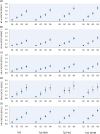Association of triglyceride-glucose index and its related parameters with atherosclerotic cardiovascular disease: evidence from a 15-year follow-up of Kailuan cohort
- PMID: 38898520
- PMCID: PMC11188278
- DOI: 10.1186/s12933-024-02290-3
Association of triglyceride-glucose index and its related parameters with atherosclerotic cardiovascular disease: evidence from a 15-year follow-up of Kailuan cohort
Abstract
Background: Triglyceride glucose (TyG) index and its related parameters have been introduced as cost-effective surrogate indicators of insulin resistance, while prospective evidence of their effects on atherosclerotic cardiovascular disease (ASCVD) remained scattered and inconsistent. We aimed to evaluate the association of TyG and its related parameters with new-onset ASCVD, and the predictive capacity were further compared.
Method: A total of 95,342 ASCVD-free participants were enrolled from the Kailuan study. TyG and its related parameters were defined by fasting blood glucose, triglyceride, body mass index (BMI), waist circumstance (WC) and waist-to-height ratio (WHtR). The primary outcome was incident ASCVD, comprising myocardial infarction (MI) and ischemic stroke (IS). Cox proportional hazard models and restricted cubic spline (RCS) analyses were adopted to investigate the association between each index and ASCVD. The C-index, integrated discrimination improvement (IDI), and net reclassification improvement (NRI) were used for comparison of their predictive value for ASCVD.
Results: During a median follow-up of 15.0 years, 8,031 new cases of ASCVD were identified. The incidence rate of ASCVD increased along with elevated levels of each index, and the relationships were found to be nonlinear in the RCS analyses. The hazard ratio (HR) and 95% confidence interval (95% CI) for ASCVD was 1.39 (1.35, 1.43), 1.46 (1.41, 1.50), 1.50 (1.46, 1.55), and 1.52 (1.48, 1.57) per 1 IQR increase of baseline TyG, TyG-BMI, TyG-WC, and TyG-WHtR, respectively, and the association were more pronounced for females and younger individuals aged < 60 years (Pfor interaction<0.05). Using the updated mean or time-varying measurements instead of baseline indicators did not significantly alter the primary findings. Additionally, TyG-WC and TyG-WHtR showed better performance in predicting risk of ASCVD than TyG, with the IDI (95% CI) of 0.004 (0.001, 0.004) and 0.004 (0.001, 0.004) and the category-free NRI (95% CI) of 0.120 (0.025, 0.138) and 0.143 (0.032, 0.166), respectively. Similar findings were observed for MI and IS.
Conclusions: Both the TyG index and its related parameters were significantly and positively associated with ASCVD. TyG-WC and TyG-WHtR had better performance in predicting incident ASCVD than TyG, which might be more suitable indices for risk stratification and enhance the primary prevention of ASCVD.
Keywords: Atherosclerotic cardiovascular disease (ASCVD); Triglyceride glucose (TyG); Triglyceride glucose-body mass index (TyG-BMI); Triglyceride glucose-waist circumference (TyG-WC); Triglyceride glucose-waist-height ratio (TyG-WHtR).
© 2024. The Author(s).
Conflict of interest statement
The authors declare no competing interests.
Figures


Similar articles
-
Triglyceride-glucose-related indices and risk of cardiovascular disease and mortality in individuals with cardiovascular-kidney-metabolic (CKM) syndrome stages 0-3: a prospective cohort study of 282,920 participants in the UK Biobank.Cardiovasc Diabetol. 2025 Jul 10;24(1):277. doi: 10.1186/s12933-025-02842-1. Cardiovasc Diabetol. 2025. PMID: 40640813 Free PMC article.
-
Insights into the complex relationship between triglyceride glucose-waist height ratio index, mean arterial pressure, and cardiovascular disease: a nationwide prospective cohort study.Cardiovasc Diabetol. 2025 Feb 28;24(1):93. doi: 10.1186/s12933-025-02657-0. Cardiovasc Diabetol. 2025. PMID: 40022080 Free PMC article.
-
Association between triglyceride-glucose (TyG) related indices and cardiovascular diseases and mortality among individuals with metabolic dysfunction-associated steatotic liver disease: a cohort study of UK Biobank.Cardiovasc Diabetol. 2025 Jan 13;24(1):12. doi: 10.1186/s12933-024-02572-w. Cardiovasc Diabetol. 2025. PMID: 39806394 Free PMC article.
-
Triglyceride-glucose index and the incidence of atherosclerotic cardiovascular diseases: a meta-analysis of cohort studies.Cardiovasc Diabetol. 2021 Apr 3;20(1):76. doi: 10.1186/s12933-021-01268-9. Cardiovasc Diabetol. 2021. PMID: 33812373 Free PMC article. Review.
-
Diagnostic and prognostic value of triglyceride glucose index: a comprehensive evaluation of meta-analysis.Cardiovasc Diabetol. 2024 Aug 23;23(1):310. doi: 10.1186/s12933-024-02392-y. Cardiovasc Diabetol. 2024. PMID: 39180024 Free PMC article. Review.
Cited by
-
A comparison between lipid-based vs. glycemic-based insulin sensitivity indices for the association with abnormal ECG findings and 20-year mortality among older adults.Cardiovasc Diabetol. 2024 Dec 18;23(1):438. doi: 10.1186/s12933-024-02533-3. Cardiovasc Diabetol. 2024. PMID: 39696234 Free PMC article.
-
Triglyceride-glucose-related indices and risk of cardiovascular disease and mortality in individuals with cardiovascular-kidney-metabolic (CKM) syndrome stages 0-3: a prospective cohort study of 282,920 participants in the UK Biobank.Cardiovasc Diabetol. 2025 Jul 10;24(1):277. doi: 10.1186/s12933-025-02842-1. Cardiovasc Diabetol. 2025. PMID: 40640813 Free PMC article.
-
Association of C-reactive protein-triglyceride glucose index with the incidence and mortality of cardiovascular disease: a retrospective cohort study.Cardiovasc Diabetol. 2025 Aug 1;24(1):313. doi: 10.1186/s12933-025-02835-0. Cardiovasc Diabetol. 2025. PMID: 40750895 Free PMC article.
-
Can cardiovascular health and its modifiable healthy lifestyle offset the increased risk of all-cause and cardiovascular deaths associated with insulin resistance?Cardiovasc Diabetol. 2025 Mar 10;24(1):114. doi: 10.1186/s12933-025-02674-z. Cardiovasc Diabetol. 2025. PMID: 40065337 Free PMC article.
-
Insights into the complex relationship between triglyceride glucose-waist height ratio index, mean arterial pressure, and cardiovascular disease: a nationwide prospective cohort study.Cardiovasc Diabetol. 2025 Feb 28;24(1):93. doi: 10.1186/s12933-025-02657-0. Cardiovasc Diabetol. 2025. PMID: 40022080 Free PMC article.
References
-
- Roth GA, Mensah GA, Johnson CO, Addolorato G, Ammirati E, Baddour LM, Barengo NC, Beaton AZ, Benjamin EJ, Benziger CP, et al. Global burden of cardiovascular diseases and risk factors, 1990–2019: update from the GBD 2019 study. J Am Coll Cardiol. 2020;76(25):2982–3021. doi: 10.1016/j.jacc.2020.11.010. - DOI - PMC - PubMed
-
- Wang W, Hu M, Liu H, Zhang X, Li H, Zhou F, Liu YM, Lei F, Qin JJ, Zhao YC, et al. Global burden of disease study 2019 suggests that metabolic risk factors are the leading drivers of the burden of ischemic heart disease. Cell Metab. 2021;33(10):1943–56. doi: 10.1016/j.cmet.2021.08.005. - DOI - PubMed
Publication types
MeSH terms
Substances
LinkOut - more resources
Full Text Sources
Medical

